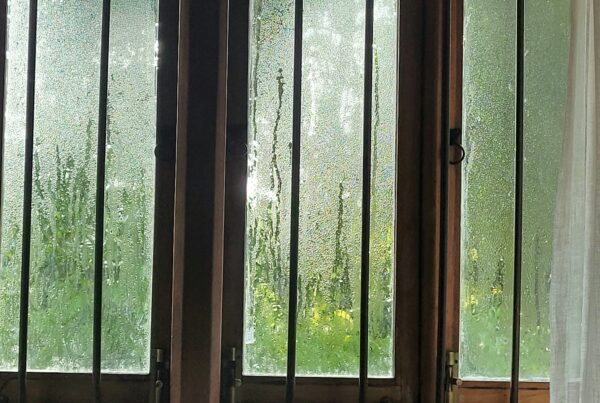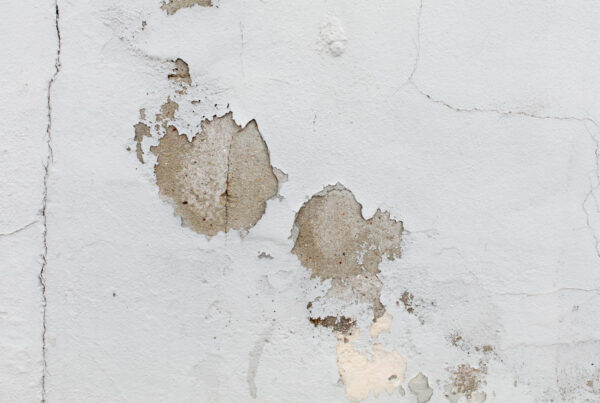Rising damp affects several UK properties, causing structural damage and creating unhealthy living conditions through moisture rising from the ground into the walls. Understanding what causes rising damp and learning about effective treatment options helps protect your property from costly damage and health risks.
In this article, discover the main causes of rising dampness, learn to identify warning signs, understand professional treatment methods, and explore prevention strategies.
What Causes Rising Damp in Properties?
Rising damp occurs when ground moisture travels upward through your property’s walls via capillary action, similar to how a sponge absorbs water. This moisture rising process happens when your home’s natural defences against groundwater fail or become compromised. The primary causes of rising damp include:
- Failed damp proof course (DPC) – The horizontal moisture barrier breaks down over time, allowing ground moisture to penetrate walls or rise from the cellar. With basement waterproofing, you can typically protect your home against water damage.
- Absent damp proof course – Older properties built before 1875 lack proper DPC installation, leaving walls vulnerable to moisture rising
- Bridged damp proof course – External ground levels raised above the DPC through landscaping or debris create moisture pathways
- Damaged DPC materials – Physical damage from building work, settlement, or deterioration compromises the moisture barrier’s effectiveness
- Porous building materials – Lime mortar and soft bricks in period properties readily absorb and transport ground moisture upward
Modern properties can also experience rising damp when DPC installation proves ineffective or becomes damaged during renovations. Heavy clay soils retain more ground moisture, increasing hydrostatic pressure against foundations and walls.
How Can You Identify Rising Damp in Your Home?
Distinctive signs of rising damp include:
- Horizontal tide marks – Dark staining appears on internal walls typically up to 1.5 metres high, creating characteristic horizontal lines
- Salt deposits (efflorescence) – White crystalline deposits form on wall surfaces as ground salts are drawn upward with moisture
- Peeling wallpaper and paint – Decorative finishes fail from the bottom upward as moisture penetrates plaster and renders it
- Crumbling plaster – Wall surfaces become soft and friable, especially around skirting board level, where moisture concentration is highest
- Musty odours – Distinctive damp smells develop in affected rooms, becoming noticeable in poorly ventilated areas
Professional moisture measurement distinguishes rising damp from other dampness types. The experienced rising damp specialists at Refresh Property Services use modern electronic technology to confirm diagnosis and determine suitable treatment strategies.
What Professional Treatments Are Available for Rising Damp?
Effective rising damp treatment requires professional intervention to install new moisture barriers and address underlying causes. Professional rising damp treatments include the following:
- Chemical DPC injection – Silicone-based chemicals injected into mortar joints create a new horizontal moisture barrier.
- Physical DPC installation – Mechanical insertion of plastic or slate membranes through wall sections provides permanent moisture protection.
- Electro-osmotic systems – Electrical systems reverse natural moisture flow, preventing capillary action from drawing groundwater upward.
- Tanking systems – Internal waterproof membranes and renders create moisture barriers on affected wall surfaces.
- External drainage – Land drainage systems reduce groundwater levels around foundations, minimising hydrostatic pressure.
Chemical DPC injection suits most residential properties and provides cost-effective long-term protection. The treatment involves drilling holes at regular intervals and injecting water-repellent chemicals that form a continuous moisture barrier. Physical DPC installation works effectively for severe cases or where chemical injection cannot penetrate dense materials.
Can You Prevent Rising Damp Problems?
Effective rising damp prevention focuses on improving the performance of existing moisture barriers and managing ground conditions around a property. Regular maintenance is more cost-effective than remedial treatments.
External ground levels should remain at least 150mm below your property’s DPC to prevent bridging. Remove soil, debris, or hard landscaping that’s accumulated against external walls. Ensure external renders do not extend below the DPC level, creating moisture pathways.
Proper drainage around foundations reduces groundwater levels and hydrostatic pressure against walls. Clear gutters, downpipes, and drainage systems prevent water accumulation near foundations. Address garden irrigation that directs water toward building foundations.
Monitor external wall conditions for signs of DPC deterioration, especially around extensions or areas where building work has occurred. Professional damp proofing assessments can identify potential problems before rising dampness develops.
When Should You Call Rising Damp Specialists?
Professional assessment is required when you identify potential rising damp symptoms or purchase older properties without modern DPC systems. Early intervention prevents extensive structural damage and reduces treatment costs.
Properties showing horizontal moisture patterns, salt deposits, or persistent ground floor dampness require specialist diagnosis to distinguish rising damp from other moisture problems. Our expertise and experience provide comprehensive property assessments using advanced diagnostic equipment to identify moisture sources and recommend suitable treatments.
Protect Your Property with Expert Rising Damp Solutions
Rising damp threatens your property’s structural integrity and creates unhealthy living conditions that worsen without professional intervention. The experienced rising damp specialists at Refresh Property Services and Consultants understand how ground moisture affects UK properties and provide comprehensive treatment solutions.
Our rising damp service and assessment combines accurate diagnosis with proven treatment methods, creating lasting moisture protection. Property owners receive detailed assessments, transparent pricing, and guaranteed results backed by decades of specialist experience. Contact us today for professional rising damp assessment and expert treatment solutions.



